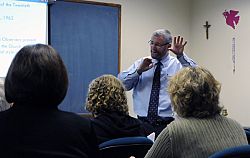Vatican II teachings covered in lecture series at the Madeleine

SALT LAKE CITY — The first in a series of presentations on the major teachings of the Second Vatican Council was given Oct. 15 to a diverse group of attendees in The Cathedral of the Madeleine’s Scanlan Hall. Gregory Glenn, the Cathedral’s director of Music and Liturgy, spoke to about 60 people of various ages and religious backgrounds about Sacrosanctum Concilium, The Constitution on the Sacred Liturgy, the first of the four constitutions that came out of the Second Vatican Council. Sacrosanctum Concilium, which may be read in English online at http://www.vatican.va/archive/hist_councils/ii_vatican_council/documents/vat-ii_const_19631204_sacrosanctum-concilium_en.html, was meant to "impart an ever increasing vigor to the Christian life of the faithful; to adapt more suitably to the needs of our own times those institutions which are subject to change; to foster whatever can promote union among all who believe in Christ; to strengthen whatever can help to call the whole of mankind into the household of the Church," according to the document’s first paragraph. Although the goal was to reform the sacred liturgy so there would be greater participation by the laity, "there was never the notion that we were going to cut ourselves off from the liturgical patrimony or tradition," Glenn said, adding that the bishops’ primary goal was to hold fast to tradition while bringing the liturgy up to date. Toward this end, great care was taken to conserve the liturgical patrimony of the church, Glenn said. One of the important principles that came out of Sacrosanctum Concilium "Is this notion that all of us have a role to play in the celebration of the liturgy; the liturgy is not the private celebration of the priest," Glenn said, adding that another development was the realization that Christ was present more broadly in the life of the Church, not simply present in the sacraments. Although many bishops vehemently opposed translating the Mass from the Latin into the vernacular, the end result of Sacrosanctum Concilium was this translation. Also, many of the liturgical rites were shortened and made clearer, Glenn said. Among the other most notable changes to the Mass was that a three-year cycle of liturgical readings was instituted. Previously, the readings were on a one-year cycle. Also, the number of Eucharistic prayers expanded from one to more than a dozen. Glenn’s presentation was a way to "have a better understanding of the purpose and results of Vatican II," said Steve Maas, who with his wife, Jackie, attended the event. "We really wanted to learn more about some of the documents that were brought about by Vatican II," said Jackie Maas, who remembers when some of the reforms were implemented. "I liked the way [Glenn] explained the changes. It brought more light to everything." "It was an opportunity to learn more about the faith," agreed Samuel Passi, who like the Maases is a Cathedral of the Madeleine parishioner. Three other Vatican II documents will be covered in future presentations. They are Dei Verbum: The Dogmatic Constitution on Divine Revelation, Oct. 22, by Father Eleazar Silva Galvin, parochial vicar of The Cathedral of the Madeleine; Lumen Gentium: The Dogmatic Constitution on the Church, Oct. 29, by Gregory Glenn; and Guadium et Spes: The Pastoral Constitution on the Church in the Modern World, Nov. 5 by Fr. Silva. All presentations begin at 7 p.m. in the Cathedral’s Scanlan Hall Adult Education Center. All are welcome to attend.
© Copyright 2024 The Diocese of Salt Lake City. All rights reserved.

Stay Connected With Us